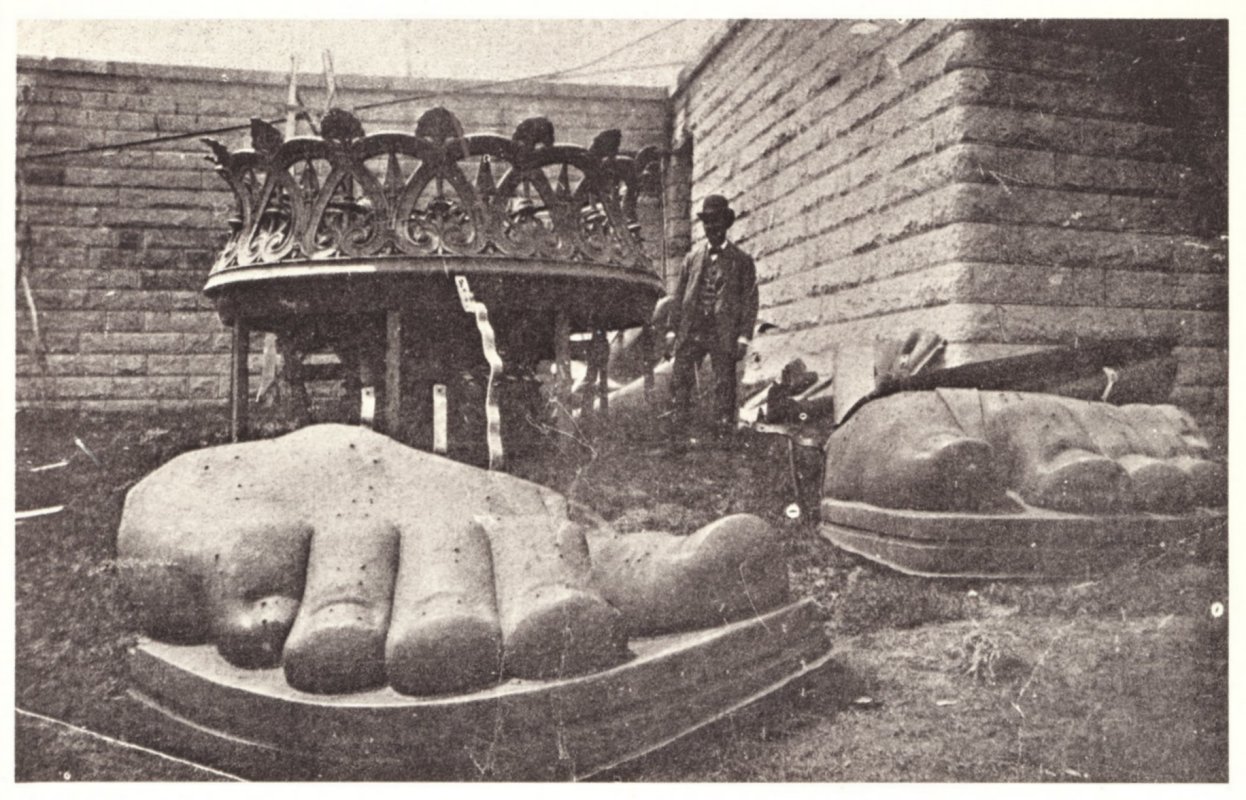The Statue of Liberty: Facts, History & Profile


Fast Statue of Liberty Facts
Height: The statue stands at a total of 305 feet, with 151 feet for the statue itself.
Weight: The statue weighs 225 tons or 450,000 pounds.
Materials: The statue is made of copper sheets that are 3/32 of an inch thick and supported by an iron framework.
Crown: The crown has seven points, each representing a different continent, and the spikes on the crown represent the rays of the sun.
Torch: The torch held by the statue is 29 feet tall and weighs 450,000 pounds, covered in 24K gold leaf, and was replaced in 1986.
Pedestal: The pedestal is 89 feet tall and is made of concrete and granite.
Foundation: The foundation is made of concrete and extends 65 feet below the surface of the ground, designed to withstand strong winds and earthquakes.
Statue of Liberty Trivia
- The statue's full name is "Liberty Enlightening the World".
- The seven spikes on the crown of the statue represent the seven oceans and the seven continents of the world.
- The statue's torch was replaced in 1986 and is now covered in 24k gold leaf.
- The statue was originally intended to be a lighthouse, but it was found to be ineffective due to its location and was never used as one.
- The statue's green color is due to the natural process of oxidation of the copper exterior.
- The statue was closed for renovation for 8 months after the 9/11 terrorist attacks in 2001.

Towering in the bay and overlooking New York City, the Statue of Liberty is an iconic symbol of American freedom and democracy, and its origins are rooted in the long-standing relationship between the United States and France. This colossal neoclassical sculpture stands on Liberty Island in New York Harbor, gazing out at the world with her torch held high as a beacon of hope and liberty for all.
In this profile, we will explore the history, design, symbolism, and significance of this world-renowned statue. So, if you’ve ever wondered how tall is the Statue of Liberty, or what is the Statue of Liberty made of, read on to discover everything about Lady Liberty!
History of the Statue of Liberty
The idea for the Statue of Liberty was first proposed by French political thinker Edouard de Laboulaye in 1865, as a way to celebrate the end of slavery in America and the Franco-American friendship. Laboulaye envisioned a grand monument that would embody the ideals of liberty, democracy, and freedom, and he believed that such a symbol would serve as a powerful reminder of the values that the United States was founded upon.
The statue was designed by French sculptor Frederic-Auguste Bartholdi, who was inspired by the ancient Colossus of Rhodes, and it was built by Gustave Eiffel, the architect of the Eiffel Tower. It was originally called 'Liberty Enlightening the World' and was intended to symbolize the values of freedom and democracy that the United States represented.
Lady Liberty was completed in France in 1884 and was shipped to the United States in 1885. It was then reassembled on a pedestal on the renamed Liberty Island in upper New York Bay. The statue quickly became a symbol of the United States and has remained an important icon of the country ever since.
The construction of the statue was largely funded by the people of France, who raised the necessary funds through a series of public and private donations. In the United States, fundraising efforts were led by publisher Joseph Pulitzer, who used his newspaper to encourage Americans to donate toward the pedestal.
It quickly became an important part of the American psyche, with more being added to the structure throughout the coming century. For instance, President Richard Nixon opened the immigration museum on Liberty Island.
In 1984, the Statue of Liberty was designated as a UNESCO World Heritage site, recognizing its cultural and historical significance. The designation has helped to preserve the statue for future generations.
The statue has undergone several renovations and restorations over the years, including a major restoration for its centennial in 1986. In 2019, a new museum called the Statue of Liberty Museum opened on Liberty Island, featuring exhibits on the history of the statue and its symbolism.
The Statue of Liberty and the Civil War
The statue also has a connection to the Civil War, as it was constructed during the 19th century, a time when the country was still healing from the wounds of the war. President Grover Cleveland dedicated the statue on October 28, 1886, as a sign of unity and hope for the future of the country.
Additionally, the statue is located on Liberty Island, which was originally known as Bedloe's Island. The island was renamed in 1956 to honor the statue's significance. And on former Bedloe’s island, there are remnants of Civil War history; the statue’s pedestal itself is situated on top of Fort Wood, a former military fortification that was used during the Civil War.
The statue's pedestal was designed by American architect Richard Morris Hunt and built in 1886.

Design of the Statue
The Statue of Liberty represents Libertas, the Roman goddess of freedom, who bears a torch and a tabula ansata (a tablet evoking the law) upon which is inscribed the date of the American Declaration of Independence. A broken chain lies at her feet.
The Statue of Liberty stands at a height of 151 feet and weighs 225 tons. It is made of copper sheets that are only 2.4 millimeters thick. The copper was pounded into shape by hand and then attached to an iron framework. The statue's torch was originally designed to shine as a beacon of hope, but it was replaced in 1986 with a new torch covered in 24-karat gold leaf.
The statue's crown features seven rays, which represent the seven continents of the world. The statue's torch represents enlightenment and the power of knowledge. It is a symbol of hope and inspiration for people all over the world.
The broken chains at her feet represent the end of slavery in America, and they are a reminder of the struggles that the United States has faced in the past.
The Statue of Liberty: Symbolism and Significance
The Statue of Liberty is a powerful symbol of American history, freedom, and democracy, representing the United States' commitment to these values. The statue has become an important icon of the United States, and it is recognized all over the world.
The statue's tablet, which features the date of the United States Declaration of Independence, July 4, 1776, is a reminder of the founding principles of the country. Indeed, the date is actually inscribed in Roman Numerals, reading “JULY IV MDCCLXXV”.
The statue's symbolism has resonated with people all over the world. Immigrants arriving in the United States would often see the statue as they approached the country, and it served as a symbol of hope and opportunity for them. As such, it has become a symbol of hope for the millions who came to America in search of a better life.
Lady Liberty, along with the Ellis Island Foundation, has become a major tourist attraction, with people from all over the world visiting to learn about American history and immigration. The statue has also been used as a symbol of freedom and democracy in other countries, and it has been replicated in various forms across the globe.
Fun Fact: Did you know there are eight exact replicas of the Statue of Liberty in Paris, and many more in different countries across the world, including Spain, Germany, Brazil, and the Philippines?
The New Colossus
The Statue of Liberty is often associated with Emma Lazarus' poem “The New Colossus”, which is engraved on a bronze plaque inside the pedestal in 1903.
The poem was written in 1883 and describes the statue as the “Mother of Exiles”, welcoming immigrants to America with open arms. It has become one of the most famous American poems, and its words have come to symbolize the spirit of the country. The poem includes the famous line, "Give me your tired, your poor, your huddled masses yearning to breathe free."
Visiting the Statue of Liberty
The Statue of Liberty is located on Liberty Island in New York Harbor, which is adjacent to Ellis Island. The statue is managed by the National Park Service and is part of the Statue of Liberty National Monument. Tickets are necessary to visit.
A popular way to visit the statue is by taking a cruise. There are several companies that offer cruises to Liberty Island, allowing visitors to see the statue up close and learn about its history and significance. The statue is also visible from several points in New York City, including Battery Park and the Staten Island Ferry.
Visitors can also access the statue directly via ferry service from Battery Park in Manhattan or Liberty State Park in New Jersey.
In recent years, the statue has become a major tourist attraction, with thousands of people visiting every day. Due to security concerns, visitors are required to go through a security screening before they can access the monument.
Summing Up the Statue of Liberty
In conclusion, the Statue of Liberty is an iconic symbol of freedom and democracy, representing the United States' commitment to these values. The statue's design and symbolism have resonated with people all over the world, and it has become an important icon of the United States.
The Statue of Liberty continues to inspire hope and opportunity for people everywhere, and it serves as a powerful reminder of the values that the United States was founded upon.
Do you want to test your newfound knowledge? Try out our New York City Quiz!
People Also Ask...
Other travelers and curious searchers have similar questions about the Statue of Liberty. Do these answer your queries?
What Is the Significance of the Statue of Liberty?
The Statue of Liberty is a symbol of freedom, democracy, and opportunity. The statue's torch represents enlightenment, and the tablet she holds in her left hand represents the rule of law. The statue has become an iconic symbol of America and is visited by millions of people from around the world each year.
What Is the Height of the Statue of Liberty?
The Statue of Liberty stands at a height of 305 feet tall on Liberty Island in New York Harbor, measured from the ground to the tip of the torch. The statue’s height itself is 151 feet.
Who Designed the Statue of Liberty?
The Statue of Liberty was designed by French sculptor Frédéric Auguste Bartholdi. He was inspired by the idea of creating a monument to commemorate the Franco-American alliance during the American Revolution.
When Was the Statue of Liberty Gifted to the United States by France?
The Statue of Liberty was gifted to the United States by France in 1886 as a symbol of freedom, democracy, and opportunity. The statue was completed in France in 1884 and shipped to the United States in crates, where it was assembled on its pedestal on Liberty Island in New York Harbor.
What Does the Tablet That the Statue Holds in Her Left Hand Represent?
The tablet that the Statue of Liberty holds in her left hand represents the rule of law. The tablet is inscribed with the date of American independence in Roman numerals, "JULY IV MDCCLXXVI" (July 4th, 1776).

About the author







